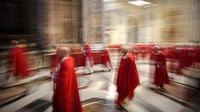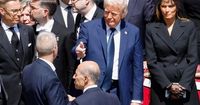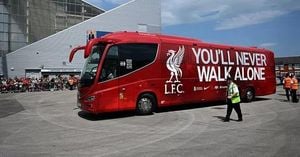Pope Francis died last week at the age of 88 in Vatican City, leaving the Catholic Church's most powerful position vacant. During daily Mass Monday at Our Lady of Perpetual Help in Soldotna, one priest remembered Francis' life and legacy.
In front of the altar at Soldotna's Catholic church, a votive candle burned in front of a framed picture of the late pope. The white wax was nearly gone – the flame having burned all the way to the bottom. In many ways, the midday Mass was business as usual for the church. But in another way, it's anything but. "We're in an extraordinary time right now – a period called sede vacante, which means 'empty chair,'" said Father Patrick Brosamer, who's been a priest for the Catholic churches in Soldotna and Kenai since 2019. "The throne of St. Peter, which of course, is occupied by the pope, is empty now."
It's estimated that more than a billion people practice Catholicism around the world. That includes roughly 15% of Alaska adults, according to the Pew Research Center. Monday's Mass paid special attention to the death of Pope Francis, who Brosamer said was sometimes referred to as a pope "from the margins." Born Jorge Mario Bergoglio in Argentina, Brosamer says Pope Francis marked a breath of fresh air for the Church in a few ways. "Although he was of Italian ancestry, he was the first pope from outside Europe in many centuries," Brosamer said. "He was the first pope from Latin America. He was the first pope from the Southern Hemisphere. And his pontificate represented a new era in the Church."
Part of that "new era" was Francis' concerted efforts to build a Catholic Church of and for the world's vulnerable. He was the first to take the name Francis, from St. Francis of Assisi, whose life was marked by a dedication to charity. And he was known for speaking out on contemporary issues, like rights for the LGBTQ+ community, and the ongoing war in Gaza.
Brosamer remembers where he was when Pope Francis was named as head of the Catholic Church more than a decade ago. It was March 2013, and he was about to graduate from seminary in Oregon – the formal education men receive before becoming ordained priests. "At the time of the conclave, we set up a big-screen TV in the main auditorium so that we all could see the new pope step out on the balcony," Brosamer said. "And when it finally happened, after we'd been waiting for a few hours, none of us recognized him, except for the guys from Argentina." Conclave refers to the process for electing a new pope. Catholic cardinals from around the world convene for secret meetings in the Sistine Chapel and cast ballots for their papal candidate of choice.
"They're sworn to secrecy about the proceedings, but typically it lasts a few days, and then the new pope will step out onto the balcony at St. Peter's and introduce himself to the world, and the crowd will cry, 'Habemus papam,' which means, 'We have a pope,'" he said.
If they fail to reach a consensus, they release black smoke from the conclave. When they've come to an agreement on a new pope, they release white smoke. Brosamer remembers the last time the Cardinal College reached consensus. "I remember middle of class word went out – white smoke," he said. "That's a big deal. In Catholic schools throughout the world, when there's white smoke, the teacher doesn't cancel class, class is over. Everybody runs out and everybody goes to the nearest TV because they want to see who the new pope is going to be."
Brosamer and about a dozen parishioners closed out Monday's Mass with a prayer for Rome. "We pray for the repose of the soul of Pope Francis, and let's pray that God may guide the cardinals as they gather in conclave, which is a very rare thing," he said to parishioners. "And let's remember that God is ultimately in control, and that's something that should give us very great confidence and peace of heart and mind." Cardinals on Monday set the conclave start date for May 7 at the Sistine Chapel in Vatican City.
In a lighter tone, former President Donald Trump has humorously positioned himself as a contender for the papacy, jokingly declaring he would be his own "number one choice" to lead the Catholic Church. Trump made the comments on Tuesday, April 29, shortly after attending Pope Francis' funeral at the Vatican. "As Pope? I’d like to be Pope," he grinned when asked who he believed should become the new pontiff.
While Trump’s jest was met with laughter, he quickly shifted gears, suggesting Cardinal Timothy Dolan, the Archbishop of New York, as a viable candidate. "No, I don’t know, I have no preference," Trump added, praising Dolan’s capabilities. Dolan is among nine American cardinals expected to attend the conclave, which opens at the Vatican next week.
Trump’s visit to the Vatican was closely monitored, especially as he engaged with world leaders, including Ukrainian President Volodymyr Zelensky. However, his choice of attire – a navy blue suit instead of the customary black – drew criticism on social media.
Meanwhile, as the cardinals prepare for the conclave, they have been meeting daily since April 22 to discuss the future direction of the Church. Cardinal Louis Sako, the patriarch of the Chaldean Catholic Church, characterized the atmosphere as "fraternal and sincere," while Cardinal Jorge Jiménez Carvajal noted a "great spirit of communion" among the cardinals.
Cardinal Sako emphasized the responsibility of finding a successor who can continue the work of Pope Francis, who was known for advocating a welcoming Church. Cardinal Rosa Chávez highlighted the need for an inclusive approach, stating, "The next pope could be a surprise, just as Pope Francis was a surprise for most."
The conclave, set to begin on May 7, will follow a long-standing tradition of electing the next pope, with cardinals voting in secret until a candidate receives a two-thirds majority. The process is a sacred and private election, taking place in the Sistine Chapel, a venue steeped in history and artistry.
As the world watches, the Catholic Church stands at a pivotal moment in its history, seeking a leader who can navigate the complexities of modern society while staying true to its foundational principles.





